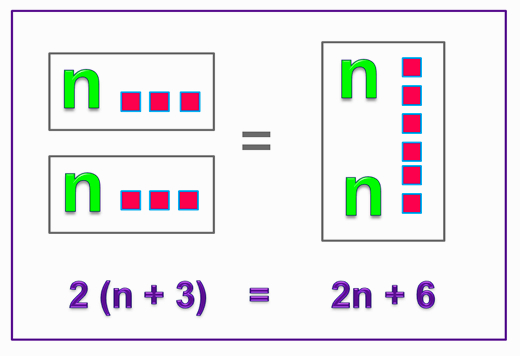
Image Copyright 2012 by Passy’s World
We use some special methods for multiplying Algebra terms involving brackets.
This is because the normal BODMAS / Pemdas methods for brackets do not work well for Algebra.
In this lesson we look at how to expand a single set of brackets.
These expressions have a single term on the outside of the brackets, and two Algebra terms inside the brackets.
The terms inside the brackets might be added or subtracted, depending on what is has in the original question.
The special multiplying rule that we use is called the “Distributive Property”, and means we distribute the term outside the brackets onto all the terms inside the brackets.
This is the same idea as the Red Cross distributing food packages to all of the houses inside a town that has been hit by a disaster.

Image Source: http://www.icrc.org
The Distributive process is also used in car engines.
Distributing Charge to all of the spark plugs in the engine is done by a device called the “Distributor”.
Introduction to Distributive Property Video
The following video by Professor Perez gives a good overview of what we are covering in this lesson.
We recommend watching this video before reading the material in the rest of this lesson.
Introduction to the Distributive Rule
Consider the single bracket expression: 2 ( 4 + 3)
Most people would use BODMAS or Pemdas to do the brackets first, and then multiply by the 2.
The answer would then be 2 x 7 = 14 .
There are actually three ways that we can work out this multiply question:
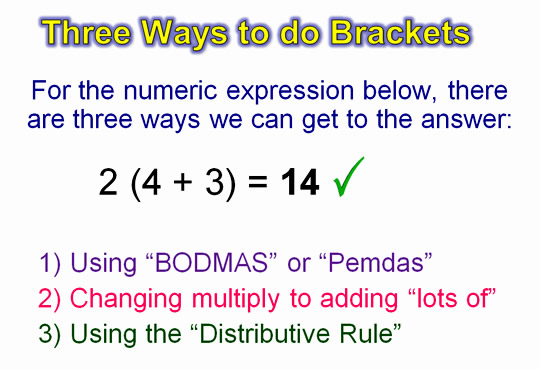
Image Copyright 2012 by Passy’s World
The quickest way to get the correct answer of 14, would be to use BODMAS” or “Pemdas” Order of Operations, and do the “Brackets” (or “Parenthesis”), before doing the “Multiplying”.

Image Copyright 2012 by Passy’s World
The second way we could do this question by converting the multiplication into an addition sum.
Eg. 2 x (4 + 3) means “two lots of four and three”, and so we can write: (4 + 3) + (4 + 3), 7 + 7 = 14 .
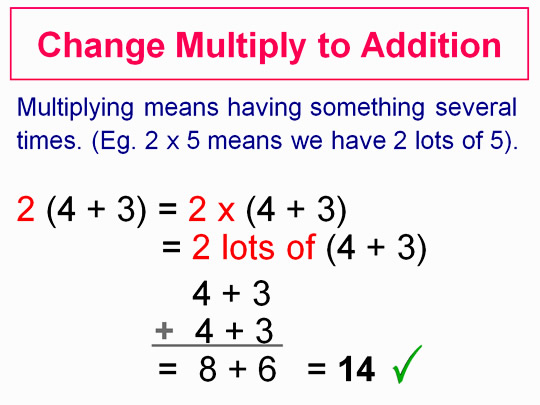
Image Copyright 2012 by Passy’s World
The third was of doing this question is a new way, that we need to learn for Algebra.
It is called the “Distributive Law”, or the “Distributive Property”, or the “Distributive Rule”, or “Expanding Single Brackets”, or the “Distributive Method”, or the “Crab Claw Method”.
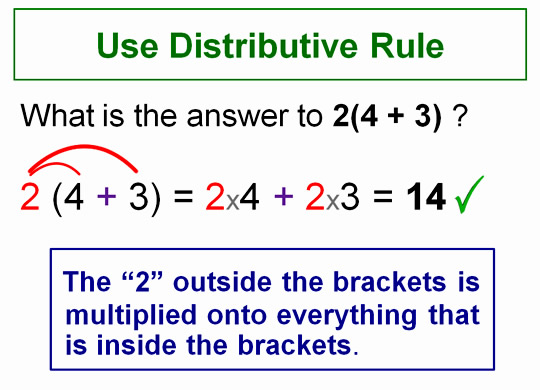
Image Copyright 2012 by Passy’s World
The Crab Claw Method

Image Source: http://www.ceramicmosaicart.com
Here at Passy World we have found the idea of the “Crab Claw” method as one which students seem to easily remember.
The concept involves thinking about the outside number as a big red crab, who reaches his claw in and grabs both the numbers inside the bracket and multiplies them.
Diagramatically, we can represent this as follows.
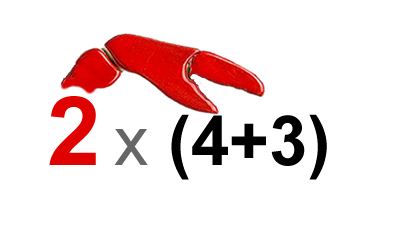
Image Copyright 2012 by Passy’s World
So each time we draw red arrows on a question on the board to show the outside number distributing onto both of the inside numbers, we mention this being the crab claw which reaches in and multiplies both numbers.
The crab claw never alters the add or subtract sign inbetween the terms, and this sign stays intact as we work through the process.
Don’t ask me why, but this concept seems to work well to help students grasp and remember the Distributive process.
The big drawback is that the “crab claw” idea only works when we have two terms inside the brackets, and does not really cover three terms inside brackets expansions.

Image Copyright 2012 by Passy’s World
Why Use the Distributive Property
The Distributive method needs to be used whenever we have letter terms in the brackets, because BODMAS / Pemdas will not work on these.
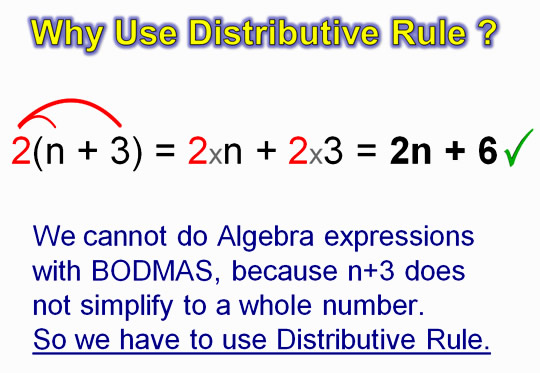
Image Copyright 2012 by Passy’s World
We need to expand Algebra bracket terms so that we can Solve Equations and Draw Graphs.

Image Copyright 2012 by Passy’s World
We will not be covering Equations and Graphs in this lesson, but they are covered in other lessons on our website.
(Check our “Index” page to find these lessons).
Distributive Rule and Subtraction
We can also use the Distributive Property on bracket terms which contain a subtraction sign.
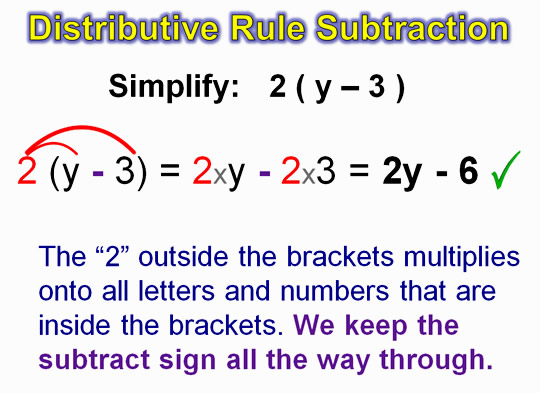
Image Copyright 2012 by Passy’s World
Distributive Rule with Integers and Exponents
The Distributive Property can also be used on three item terms, Exponents, and Integers, as shown in the following examples.
For three items, simply make sure that the outside number gets multiplied onto all three of the inside numbers.
This results in having three terms in the resulting answer.
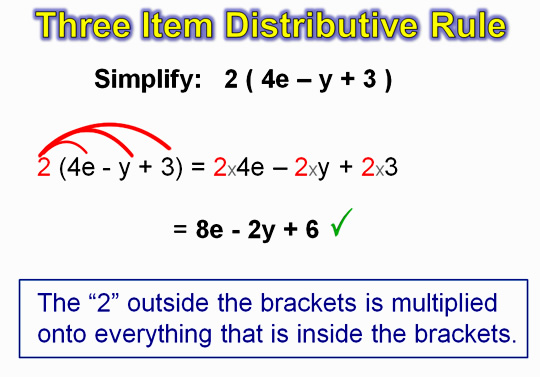
Image Copyright 2012 by Passy’s World
When there is a negative integer outside of the brackets, use integer multiplication rules to make the signs of answer terms.
It may also be necessary to use “Keep Flip Change” Rule on some subtractions, and flip a subtraction sign into an addition sign, as well as changing the sign of the negative term to positive.
This is shown in the following example.
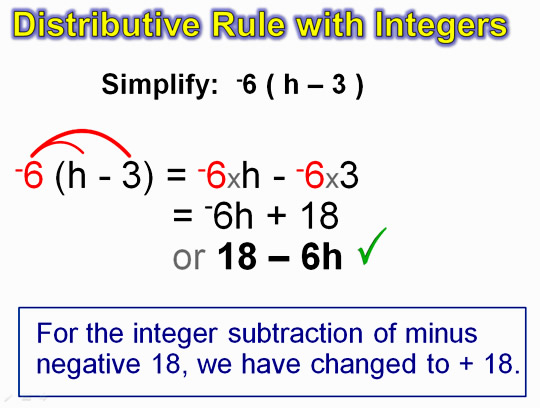
Image Copyright 2012 by Passy’s World
Terms containing Exponents can also have distributive multiplication applied to them.
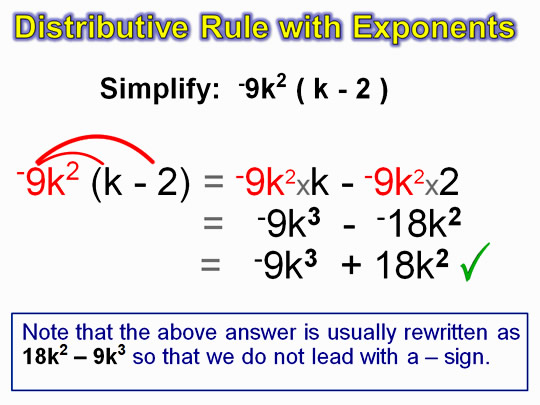
Image Copyright 2012 by Passy’s World
If you are unsure about Exponents, then check out our previous lessons on this material at the links below:
http://passyworldofmathematics.com/multiplying-basic-alegebra-terms/
http://passyworldofmathematics.com/basic-exponents-and-indices/
http://passyworldofmathematics.com/multiplying-algebra-exponents/
Size of Distributed Answer
Most distributive multiplication answers have two items in them, connected together by either and addition or subtraction sign.
If your answer does not have two separate terms in it, then check your work carefully.
It is possible to have only one term in the answer and be correct; but this only happens when some like terms have cancelled out after the exapnsion.
It is also possible to have three or more terms in the final answer, if the original question had three or more terms inside the brackets.
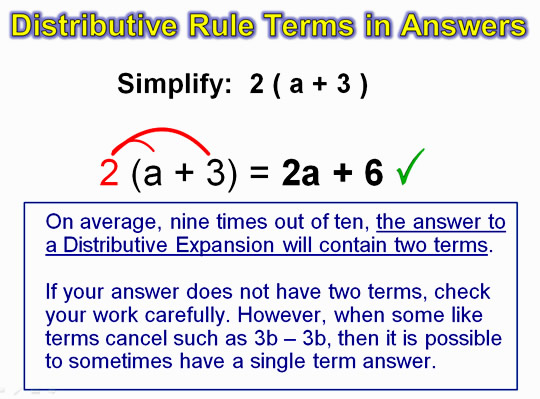
Image Copyright 2012 by Passy’s World
Videos About Distributive Property
The following video explains clearly how to use the Distributive Multiplication Method.
This next video shows common mistakes that can be made when using the Distributive Property.
Distributive Property With Like Terms
In more involved questions, there are often “Like Terms”, that need to be collected together after we have done our Distributive steps.
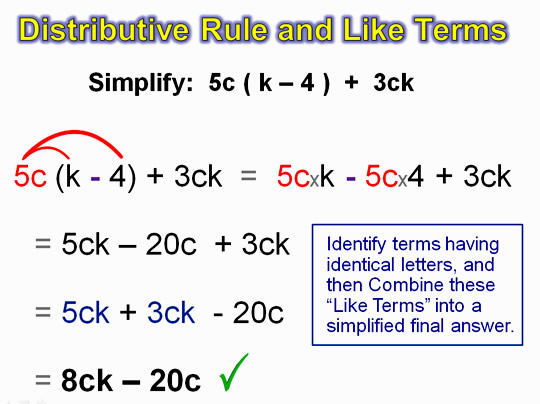
Image Copyright 2012 by Passy’s World
Some questions are quite long, where we have to expand two lots of brackets, and then collect the Like Terms.

Image Copyright 2012 by Passy’s World
This final example shows how to do a double distributive property question that contains exponents.
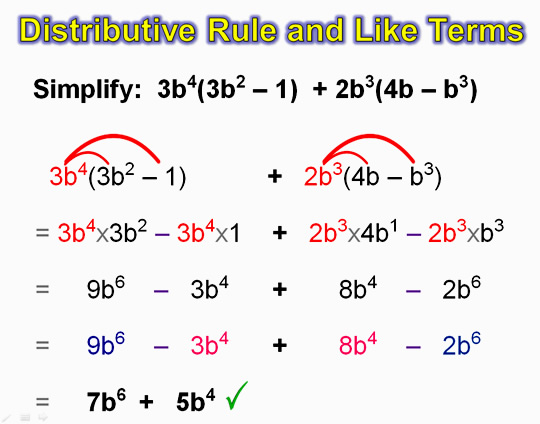
Image Copyright 2012 by Passy’s World
Distributive Property Music Video
This story followed by music video is really out there, but does demonstrate the Distributive Property with an animated story, a chipmunks song, and some claymation. It is certainly unique !
Related Items
Algebra Expressions
Algebra Terms Coefficients Variables and Constants.
Algebra Substitution Using Positive Numbers.
Algebra Substitution Using Negative Numbers.
Basic Powers Exponents and Indices.
Substitution Using Powers Exponents and Indices.
Identifying and Combining Like Terms.
Basic Algebra Multiplication.
Algebra Exponents Multiplication.
Algebra Dividing.
Real World Algebra Formulas
Survivor Algebra – Class Activity
If you enjoyed this post, why not get a free subscription to our website.
You can then receive notifications of new pages directly to your email address.
Go to the subscribe area on the right hand sidebar, fill in your email address and then click the “Subscribe” button.
To find out exactly how free subscription works, click the following link:
If you would like to submit an idea for an article, or be a guest writer on our blog, then please email us at the hotmail address shown below.
If you are a subscriber to Passy’s World of Mathematics, and would like to receive a free PowerPoint version of this lesson valued at $4.99, but 100% free to you as a Subscriber, then email us at the following address:
Please state in your email that you wish to obtain the free subscriber copy of the “Distributive Property” PowerPoint.
Feel free to link to any of our Lessons, share them on social networking sites, or use them on Learning Management Systems in Schools.
Like Us on Facebook
Our Facebook page has many additional items which are not posted to this website.
These include items of mathematical interest, funny math pictures and cartoons, as well as occassional glimpses into the personal life of “Passy”.
Check it out at the following link:
https://www.facebook.com/PassysWorldOfMathematics
While you are there, LIKE the page so you can receive our FB updates to your Facebook News Feed.
Help Passy’s World Grow
Each day Passy’s World provides hundreds of people with mathematics lessons free of charge.
Help us to maintain this free service and keep it growing.
Donate any amount from $2 upwards through PayPal by clicking the PayPal image below. Thank you!
PayPal does accept Credit Cards, but you will have to supply an email address and password so that PayPal can create a PayPal account for you to process the transaction through. There will be no processing fee charged to you by this action, as PayPal deducts a fee from your donation before it reaches Passy’s World.
Enjoy,
Passy

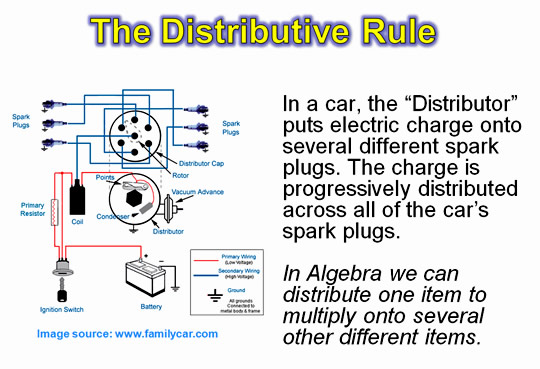




Pingback: Expanding Two Brackets Binomials | Passy's World of Mathematics
Pingback: Factorising With Common Factors | Passy's World of Mathematics
Pingback: Variable On Both Sides Equations | Passy's World of Mathematics
Pingback: Fractions on Both Sides Equations | Passy's World of Mathematics